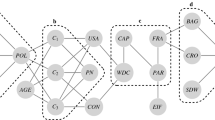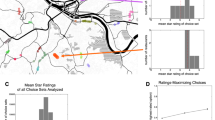Abstract
Modelling the cognitive process is a challenging task. Contextual conditions and the scope of the options are critical factors that influence human decisions. We propose and formulate an attention-based network to model the various choices made by humans based on the various factors that predict the possible option in each scope. To evaluate our proposed method, we conducted a user choice experiment in which a user chose an option from among limited choices. Our results showed that our model successfully extracted the hidden context on the attention layer and even outperformed the chance level in terms of prediction accuracy.







Similar content being viewed by others
References
Miller GA (1995) WordNet: a lexical database for english. Commun ACM 38(11):39–41
Speer R, Chin J, Havasi C (2016) ConceptNet 5.5: an open multilingual graph of general knowledge. In: Proceedings of AAAI conference on artificial intelligence
Iyengar S (2011) The art of choosing. Twelve, New York
Schafer JB, Frankowski D, Herlocker JL, Shilad S (2007) Collaborative filtering recommender systems. In: Brusilovsky P, Kobsa A, Nejdl W (eds) The adaptive web. Springer, Berlin, Heidelberg, pp 291–324
Pawar RM, Bag VV (2014) Development of context based collaborative filtering system for recommendation. Int J Eng Dev Res 2(3):3137–3142
Iyengar SS, Lepper MR (2000) When choice is demotivating: can one desire too much of a good thing? J Pers So Psychol 79(6):995–1006
Chien J, Lin T (2018) Supportive attention in end-to-end memory networks. In: IEEE 28th international workshop on machine learning for signal processing (MLSP), pp 1–6
Miller AH, Fisch A, Dodge J, Karimi A-H, Bordes A, Weston J (2016) Key-value memory networks for directly reading documents. In: Proceedings of the 2016 conference on empirical methods in natural language processing, pp 1400–1409
Wang S, Hu L, Cao L, Huang X, Lian D, Liu W (2018) Attention-based transactional context embedding for next-item recommendation. In: Thirty-second AAAI conference on artificial intelligence
Mannor S, Peleg D, Rubinstein R (2005) The cross entropy method for classification. In: Proceedings of the 22nd international conference on machine learning
Schmidhuber J (2015) Deep learning in neural networks: an overview. Neural Netw 61:85–117
Robbins H, Monro S (1951) A stochastic approximation method. Ann Math Stat 22(3):400–407
Devijver PA, Kittler J (1982) Pattern recognition: a statistical approach. Prentice-Hall, Upper Saddle River
Acknowledgements
This work was supported by Grant-in-Aid for Scientific Research on Innovative Areas, Grant numbers 19H05693
Author information
Authors and Affiliations
Corresponding author
Additional information
Publisher's Note
Springer Nature remains neutral with regard to jurisdictional claims in published maps and institutional affiliations.
This work was presented in part at the 25th International Symposium on Artificial Life and Robotics (Beppu, Oita, January 22–24, 2020).
About this article
Cite this article
Li, M., Nakamura, Y. & Ishiguro, H. Choice modeling using dot-product attention mechanism. Artif Life Robotics 26, 116–121 (2021). https://doi.org/10.1007/s10015-020-00638-y
Received:
Accepted:
Published:
Issue Date:
DOI: https://doi.org/10.1007/s10015-020-00638-y




